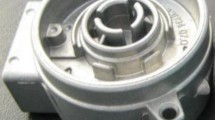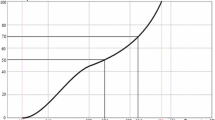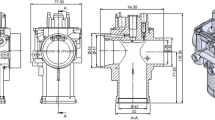Abstract
Pressure die-casting is generally useful in casting of zinc, Aluminium, magnesium, lead and tin-based alloys. Better surface finish, tolerances and dimensional accuracy can be achieved by optimization of significant process parameters of Pressure die casting (PDC) such as solidifying-time, melting-temperature, fill-up-time, inoculation-pressure and plunger-velocity etc. In addition, with the proper selection of optimum process parameters the PDC defects such as flash, cold-shut, porosity, misrun, etc. also minimized. In the present work, minimization of the PDC defects using artificial intelligent technique comprises of Genetic-algorithm (GA) and fuzzy-logic-methodology (FLM). A380: A silicon based aluminium alloy carburetor-housing is considered for the same. L18 orthogonal array based Taguchi design approach is considered for number of % defects per batch in a lot of 500 components as FLM knowledge base. To estimate the extent of accuracy of predictions made by FLM, regression analysis isperformed. FLM is also validated with R-square approach. Besides this, ANOVA has also been applied to estimate the significance level in terms of percent contribution among the input parameters and defects during PDC. Solidifying-time & fill-up-time has been found most sensitive parameter. Melting-temperature, plunger-velocity and inoculation-pressure are also identified as influencing parameters with comparatively low percent contribution. To optimize process parameters GA is applied and the fitness value is calculated using FLM. From this combination of artificial intelligent approach an optimum combination of process parameter has been obtained. Further, the results are compared with the Taguchi methodology and the approach provides appreciable amount of decrease in PDC-defects by fine tuning the input parameter.
Similar content being viewed by others
References
Janudom S, Rattanochaikul T, Burapa R (2010) Feasibility of semi-solid die casting of ADC12 Aluminium alloy. Trans Nonferrous Metal Soc China 20(9):1756–1762
Tsoukalas VD (2011) An adaptive neuro-fuzzy inference system (ANFIS) model for high pressure die casting. Proc Inst Mech Eng B J Eng Manuf 225(12):2276–2286
Rheinfeldengroup (2008) Primary Aluminium alloys for pressure dies casting. Handbook-Die-Casting-Aluminium-Alloys
Park YK, Yang JM (2013) A scheme of supplementary production in linear programming scheduling of die casting processes. Proc Inst Mech Eng B J Eng Manuf 227(6):855–865
Wang Y, Wu S, Niu L (2014) Optimization of low-pressure die casting process parameters for reduction of shrinkage porosity in ZL205A alloy casting using Taguchi method. Proc Inst Mech Eng B J Eng Manuf 228(11):1508–1514
Md AH, Jena BK, Mohanta DK (2017) Optimization of process parameters in cold chamber pressure die casting using doe. Int Res J Eng Tech 4(4):2108–2114
Tsoukalas VD, Mavrommatis A, Orfanoudakis NG (2004) A study of porosity formation in pressure die casting using the Taguchi approach. J Mat Sci Eng 218(1):77–86
Rajkolhe R, Khan JG (2014) Defects, causes and their remedies in casting process: a review. Int J Res Advent Tech 2(3):375–383
Narasimha M, Rejikumar R, Sridhar K (2013) Statistical methods to optimize process parameters to minimize casting defects. Int J Mech Eng Tech (IJMET) 4(3):11–23
Li J, Oberdorfer B, Habe D, Schumacher P (2018) Determining casting defects in near-net shape casting. Aluminium Parts by Computed Tomography 13(1):48–52
Świłło SJ, Myszka D (2011) Advanced metrology of surface defects measurement for Aluminium die casting. Archives of Foundry Engineering, Published quarterly as the organ of the Foundry Commission of the Polish. Acad Sci 11(3):227–230
Anastasiou KS (2002) Optimization of the aluminium die casting process based on the Taguchi method. J Eng Manuf 216(7):969–977
Gao H, Zhang Y, Fu Y, Mao T, Zhou H, Li D (2018) Process parameters optimization using a novel classification model for plastic injection molding. Int J Adv Manuf Technol 94(1–4):357–370
NoorulHaq A, Guharaja S, Karuppannan KM (2009) Parameter optimization of CO2 casting process by using Taguchi method. Int J Interactive Design Manuf 3(1):41–50
Sharma N, Kumar K, Raj T, Kumar V (2019) Porosity exploration of SMA by Taguchi, regression analysis and genetic programming. J Intelligent Manuf, Springer 30(1):139–146
Syrcos GP (2003) Die casting process optimization using Taguchi method. J Mater Process Technol 135(3):68–74
Lee J, Rhee S (2000) Prediction of process parameters for gas metal arc welding by multiple regression analysis. Proc Inst Mech Eng B J Eng Manuf 214(6):443–449
Oktem H, Rzurumlu T, Col M (2006) A study of the Taguchi optimization method for surface roughness in finish milling of mold surfaces. International. J Advan Manuf Technol 28(3):694–700
Kumar D, Gupta AK, Chandna P (2015) Optimization of neural network parameters using Grey–Taguchi methodology for manufacturing process applications. Proc Inst Mech Eng C J Mech Eng Sci 229(14):2651–2664
Patel GCM, Krishna P, Parappagoudar MB (2016) Modeling and multi-objective optimization of squeeze casting process using regression analysis and genetic algorithm. Aust J Mech Eng 14(3):182–198
Tofigh AA, Rahimipour MR, Shabani MO (2015) Application of the combined neuro-computing, fuzzy logic and swarm intelligence for optimization of compo cast nanocomposites. J Compos Mater 49(13):1653–1663
Ratna S, Prasad D (2014) Application of artificial neural network for optimization of cold chamber Aluminium die casting. Int J Innov Res Adv Eng 1(5):43–47
Hsiang SH, Lin YW, Lai JW (2012) Application of fuzzy-based Taguchi method to the optimization of extrusion of magnesium alloy bicycle carriers. J Intell Manuf 23(3):629–638
Tsoukalas VD (2008) Optimization of injection conditions for a thin-walled die-cast part using a genetic algorithm method. Proc Inst Mech Eng B J Eng Manuf 222(9):1097–1106
Perzyk M, Kochanski A (2003) Detection of causes of casting defects assisted by artificial neural networks. Proc Inst Mech Eng B J Eng Manuf 217(9):1279–1284
Srinivasan L, Khan MC, Kannan TDB (2019) Application of genetic algorithm optimization technique in TIG welding of 15CDV6 aerospace steel. Silicon 11:459–469
Kumar S, Gupta AK, Chandna P (2019) State of art optimization techniques for machining parameters optimization during milling. Int J Eng Adv Technol 8(6):5104–5114
Ming L, Zailin G, Shuzi Y (1996) Mobile robot fuzzy control optimization using genetic algorithm. Artif Intell Eng 10(4):293–298
Lan TS (2010) Fuzzy linguistic optimization on surface roughness for CNC turning. Math Prob Eng Math Prob Eng:1–10
Shahali H, Soleymani Yazdi MR, Mohammadi A (2012) Optimization of surface roughness and thickness of white layer in wire electrical discharge machining of DIN 1.4542 stainless steel using micro-genetic algorithm and signal to noise ratio techniques. Proc Inst Mech Eng B J Eng Manuf 226(5):803–812
Patel GCM, Krishna P, Parappagoudar MB (2016) Modeling and multi-objective optimization of squeeze casting process using regression analysis and genetic algorithm. Aust J Mech Eng 14(3):182–198
Byne DM, Taguchi T (1987) The Taguchi approach to parameter design, quality progress. Qual Prog:19–26
Taguchi G (1986) Introduction to quality engineering. Asian Productivity Organization, Tokyo, Japan
Majumder H, Maity KP (2018) Predictive analysis on responses in WEDM of titanium grade 6 using general regression neural network (GRNN) and multiple regression analysis (MRA). Silicon 10:1763–1776
Kumar S, Chandna P, Bhushan G (2020) Prediction and optimization of work-piece temperature during 2.5-D milling of Inconel625 using regression and genetic algorithm. Cogent Eng 7(1):1–17
Kumar S, Gupta AK, Chandna P (2014) Minimization of non-productive time during 2.5D milling. World Acad Sci Eng Technol 8(6):1155–1160
Kumar A, Vinod V, Kumar J (2013) Multi-response optimization of process parameters based on response surface methodology for pure titanium using WEDM process. Int J Adv Manuf Technol 68(9–12):2645–2668
Kumar S, Gupta AK, Chandna P (2012) Optimization of process parameters of pressure die casting using Taguchi methodology. World Acad Sci Eng Technol 6(8):590–594
Chate GR, Patel GCM, Kulkarni RM (2018) Study of the effect of Nano-silica particles on resin-bonded Moulding sand properties and quality of casting. Silicon 10:1921–1936
Acknowledgements
The authors highly acknowledge Auto Dellorto Ltd. Faridabad, for providing the necessary production line for experimentation and other facilities during this work.
Funding
There is no funding agency for this research work.
Author information
Authors and Affiliations
Corresponding author
Ethics declarations
Declaration of Conflicting Interests
The author(s) declared that we have no potential conflicts of interest with respect to the research, authorship and publication of this article.
Additional information
Publisher’s Note
Springer Nature remains neutral with regard to jurisdictional claims in published maps and institutional affiliations.
Rights and permissions
About this article
Cite this article
Gupta, A.K., Kumar, S., Chandna, P. et al. Optimization of Process Parameters during Pressure Die Casting of A380: a Silicon-Based Aluminium Alloy Using GA & Fuzzy Methodology. Silicon 13, 2429–2443 (2021). https://doi.org/10.1007/s12633-020-00594-z
Received:
Accepted:
Published:
Issue Date:
DOI: https://doi.org/10.1007/s12633-020-00594-z




